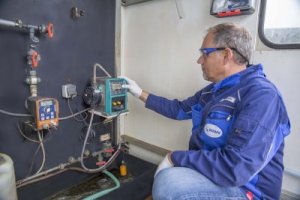The OOWV, or Oldenburgisch-Ostfriesischer Wasserverband, is a regional water association in the East Frisia region of Germany that purifies waste water from more than 500,000 people through a network of 46 water treatment plants. In addition to household waste water, the plants treat a large volume of waste water from industrial processes.
The phosphorous levels in the inflow water are relatively high – at around 15 mg/l on average. While their prescribed phosphorous limit at the point of entry is 2.0 mg/l, the plant strives to not exceed the target limit of 0.5 mg/l.
To achieve this reduction, this German waste water facility uses chemical coagulation to convert the phosphate solution in the water into insoluble phosphate compounds that can then be isolated. At this facility, one diaphragm pump had supplied the coagulant from underground storage containers into the holding tank, with the actual dosing handled by two additional diaphragm pumps – one in constant use and one in standby mode in the event of a failure. Unfortunately, failure had been an increasingly common outcome as the diaphragm pumps were often corroded by the chemical coagulants, causing frequent pump replacement.
Another problem with the diaphragm pumps had been suction. Air would be drawn in, which could jam the valves, resulting in the inability of the diaphragm pumps to prime and pump. As a result, the phosphorous limits discharged from the plant increased, which resulted in the relevant authorities being notified. To avoid this, emergency operations at night or during the weekend had become more frequent.
The problem occurred most often when the stock of coagulant was replenished. Here, the chemical dosing lines had to be manually flooded with water to enable the diaphragm pumps to operate.
Read how the German Water Treatment Plant solved the problem!




